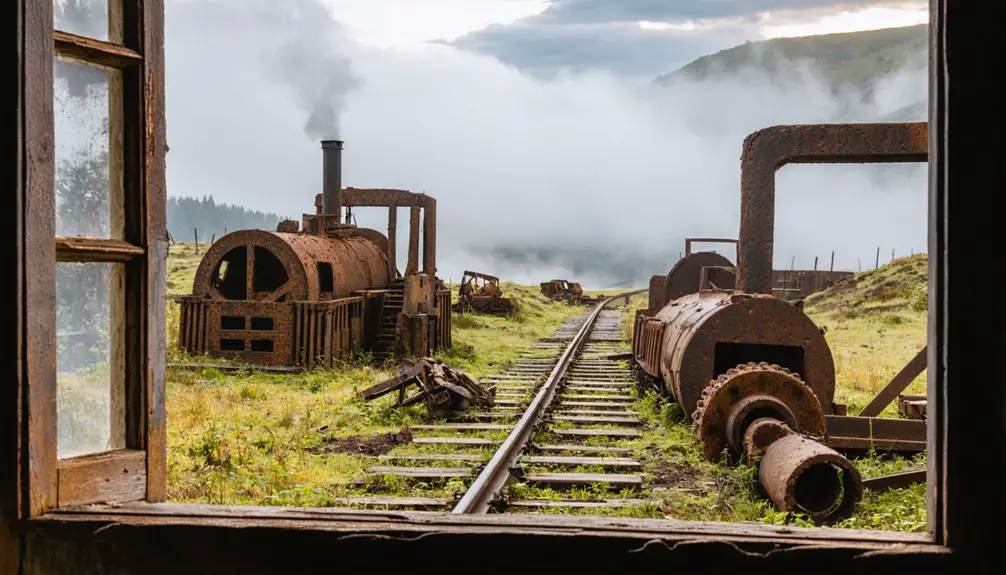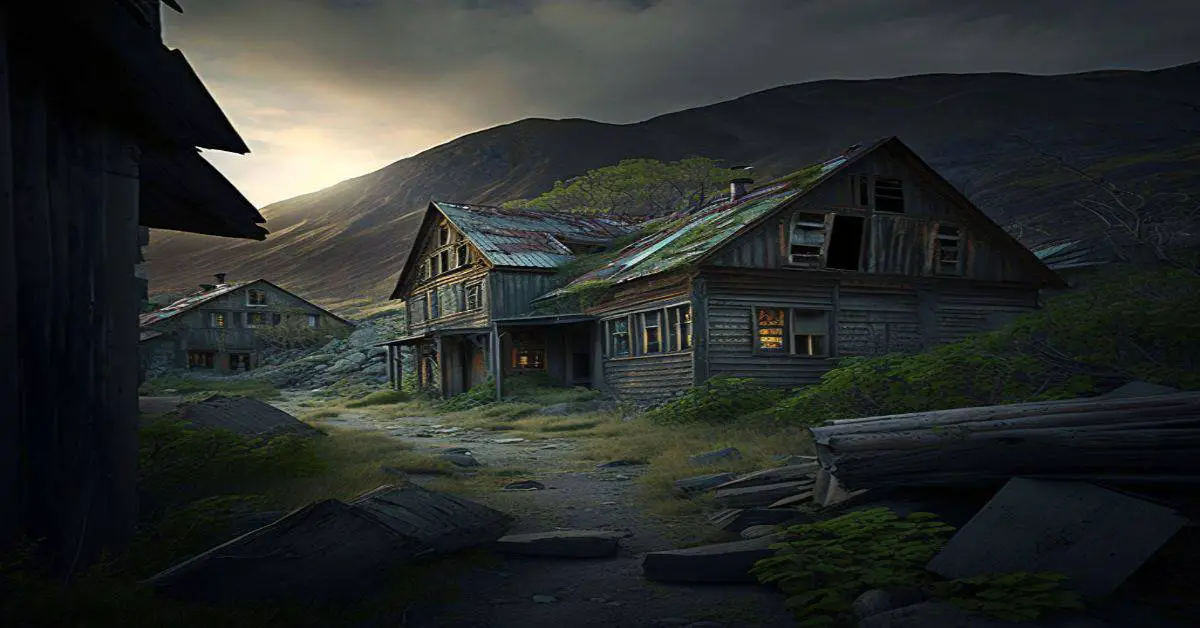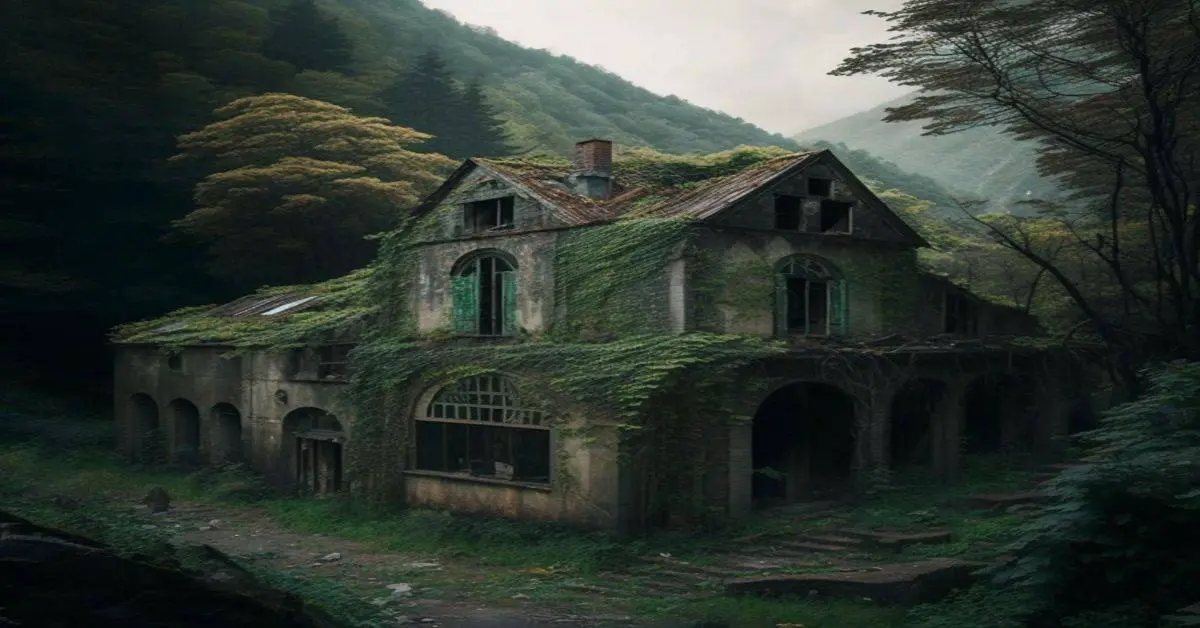You’ll find Mansfield’s ghost town ruins in Michigan’s Upper Peninsula, where W.S. Calhoune’s 1889 iron ore discovery sparked a mining boom. The town flourished with railways, homes, and busy streets until tragedy struck in 1893 when the Michigamme River flooded the mine, killing 27 miners. A devastating forest fire in 1894 destroyed most structures, and by 1915, Mansfield was abandoned. Today, nature has reclaimed the site, but beneath the wild growth lies a story of ambition, disaster, and loss.
Key Takeaways
- Mansfield was established in 1889 after W.S. Calhoune’s iron ore discovery, becoming a bustling mining town with essential infrastructure.
- A catastrophic mine flood in 1893 killed twenty-seven miners when the Michigamme River breached the mine’s walls.
- The devastating forest fire of 1894 destroyed most of Mansfield’s structures, causing mass displacement of residents.
- The mine’s closure in 1913 led to Mansfield’s official ghost town status by 1915, after producing 1.4 million tons of ore.
- Nature has reclaimed the abandoned township, with forests covering industrial ruins while preserving historic remnants for ghost tourism.
The Rise of a Mining Boomtown
After W.S. Calhoune struck iron ore in 1889, you’ll find that Mansfield emerged swiftly from Michigan’s wilderness. The discovery sparked a rush of mining techniques that would shape the area’s destiny. Within months, surveyors platted the town, anticipating the influx of fortune-seekers and their families.
Iron ore’s discovery in 1889 transformed Mansfield from pristine wilderness into a bustling frontier settlement filled with ambitious prospectors.
You’d have witnessed remarkable community resilience as Mansfield transformed from forest to frontier boomtown. The railroad’s arrival in 1890 proved essential, connecting the isolated settlement to larger markets. The Mansfield Mining Company began operations immediately after the railway was completed. The bustling town soon supported two local saloons where workers gathered after their shifts.
By 1891, a post office served the growing population, while businesses sprouted to meet miners’ needs. Local entrepreneurs established boarding houses for single workers, general stores stocked mining supplies, and saloons offered respite from long underground shifts.
Even a shingle mill opened, supporting the town’s rapid construction needs.
Life in Early Mansfield
While iron ore drew workers to Mansfield, it was daily life that shaped the community’s character in the early years.
You’d find miners and their families living in wooden frame houses near the mine, creating tight-knit neighborhoods along the Michigamme River. The community’s immigrant influences brought diverse cultural traditions, while churches and schools served as social anchors.
Life wasn’t easy – you’d have relied heavily on the mining company for basic needs and supplies. Most families supplemented their mining income through small-scale farming, and the railroad connection to Crystal Falls provided essential goods. The area’s indigenous history as Meicigama territory added deeper layers to the settlement’s story.
Despite harsh conditions and dangerous work, community resilience emerged through shared hardships and social bonds. Daily survival meant depending on neighbors and finding strength in collective experiences.
The Tragic Mine Flood of 1893
As you stand at the edge of what was once the Mansfield mine, it’s hard to imagine that fateful night in 1893 when the Michigamme River burst through just 35 feet of riverbed into the fifth level shaft.
The night boss heard the crash and ordered an immediate evacuation, but in the pitch darkness caused by extinguished lanterns, only eighteen miners managed to climb to safety through the water-filled shafts.
Despite desperate attempts to escape the rising waters, twenty-seven miners, mostly of Cornish descent, lost their lives as the river rapidly flooded the mine’s six levels. The mine was considered one of the region’s most dangerous operations even before the disaster. After the tragedy, workers diverted the river to redeem the mine, which continued operations until 1911.
River Breach Details
On the evening of September 28, 1893, the Michigamme River violently breached the Mansfield mine’s roof, releasing a catastrophic flood that would claim 27 miners’ lives.
You can trace the disaster’s origins to compromised riverbed stability, as years of mining had weakened the natural barrier beneath the waterway. Prior to the tragedy, miners routinely heard logs grinding overhead while working in the tunnels.
The night shift’s initial observations of increased water flow didn’t trigger enough concern about mining safety until it was too late.
- At 9:00 PM, workers heard an ominous crack before the cave-in unleashed a torrent of water, mud, and ore.
- Within minutes, the flood overwhelmed the mine’s pump systems and filled the tunnels.
- By 9:30 PM, Old No. 1 shaft had collapsed, sealing the miners’ fate as the waters continued to rise.
Today, a stone memorial site stands near Crystal Falls to honor these brave miners who lost their lives in pursuit of their livelihood.
Rescue Efforts Unfold
Shortly after the catastrophic breach at 9:00 PM, rescue teams rushed to the Mansfield mine’s entrance, where they’d face an overwhelming flood of water pouring through the shafts.
You’d have witnessed fellow miners courageously implementing rescue strategies, battling against time and nature as they cleared debris and reinforced unstable walls.
Despite their miner heroism, the collapse of Old No. 1 shaft severely hindered access to trapped workers.
Steam-powered pumps struggled against the rising waters while horse-drawn equipment and manual labor dominated the efforts.
Communication between surface teams and those below proved nearly impossible.
Due to the six-mile distance to Crystal Falls, news of the disaster’s full scope was significantly delayed.
While eighteen miners from lower levels managed to escape early on, the flood’s fury ultimately claimed twenty-seven lives.
The depth of 1,517 feet made rescue attempts especially challenging as teams worked to reach trapped miners.
The rescue operation eventually shifted to recovery as the Michigamme River’s powerful waters consumed the mine.
Forest Fire Devastation
The devastating 1894 forest fire swept through Mansfield village with unrelenting force, destroying nearly every home and structure in its path.
With limited fire prevention measures in place, the blaze consumed the already struggling mining community. Like other fires in Michigan during that era, intentional land clearing often led to uncontrolled burns. You’ll find that this disaster struck just one year after the catastrophic mine flooding, delivering a crushing blow to any remaining community resilience.
Key impacts of the fire included:
- Near-complete destruction of residential housing
- Mass displacement of local families
- Permanent damage to critical infrastructure
The fire marked a turning point in Mansfield’s decline, as many residents abandoned their properties to seek opportunities elsewhere.
Those who stayed shifted to logging or farming, but their efforts couldn’t sustain the town. By 1915, Mansfield had officially become a ghost town, leaving behind only ruins and memories of its tragic past.
Mining Operations and Economic Impact

During its operational peak from 1890 to 1913, Mansfield Mine emerged as an essential economic engine under the management of Caledonia Iron Co. and later Oliver Iron Mining Co.
The mine’s sophisticated mining techniques included six side shafts reaching depths of 1,517 feet, using wooden shoring and pillar systems to extract hard, brown iron ore.
The mine’s economic contributions transformed the region, spawning a bustling town complete with stores, saloons, a church, school, and post office by 1891.
You’ll find the Chicago & North Western Railroad‘s branch line was critical, connecting Mansfield to Escanaba for ore transport.
Despite producing 1,462,504 tons of ore, the devastating 1893 flood claimed 27 lives and marked the beginning of the mine’s decline, ultimately leading to its closure in 1913 and the town’s eventual ghost status.
Daily Life in a Michigan Mining Community
Life in Mansfield revolved around its vibrant mining community, where boardinghouses sheltered both settled families and transient workers throughout the 1890s.
The daily routines centered around the mine’s schedule, with workers descending into shafts reaching depths of 1,517 feet while their families maintained the town’s active community dynamics.
You’d find the essential elements of small-town life, including:
- Multiple general stores and grocery shops for daily necessities
- Two saloons serving as social hubs where miners gathered after shifts
- A church and school that anchored family and community life
The Chicago & North Western Railroad branch kept Mansfield connected to Crystal Falls, while stagecoach service and postal operations established in 1891 guaranteed you weren’t isolated from the outside world despite the remote mining location.
The Slow Decline and Abandonment
The 1893 mine flooding disaster marked the beginning of Mansfield’s end, as mine operations struggled and ultimately ceased in the following years.
You’d have witnessed a swift exodus of residents seeking work elsewhere, causing the population to plummet from a thriving mining community to roughly 50 people by the early 1900s.
The abandoned buildings, including the repurposed pioneer church and miners’ cabins, gradually succumbed to nature’s reclamation, leaving only scattered ruins and rusted machinery as evidence of the town’s brief industrial era.
Mining Operations Cease Operations
While Mansfield Mine produced over 1.4 million tons of iron ore during its operational years from 1890 to 1913, mounting challenges eventually forced its closure. The Oliver Mining Company’s mining technology couldn’t overcome the mine’s depleting ore deposits and economic challenges. By the early 1900s, most upper-level shafts were exhausted, making operations increasingly difficult at depths reaching 1,517 feet.
- The catastrophic 1893 Michigamme River flooding killed 27 miners and compromised the mine’s structural integrity.
- Forest fires in 1894 devastated the village infrastructure, destabilizing the mining community.
- By March 1913, all mining operations were suspended except for water pumping, marking the end of Mansfield’s mining era.
The mine’s closure transformed Mansfield from a bustling mining town into a fading community, as residents sought work elsewhere.
Population Exodus Accelerates
Following Mansfield Mine’s closure in 1913, population decline accelerated steadily throughout the twentieth century as residents sought economic opportunities elsewhere.
You’ll find that tragic events, including the devastating 1894 forest fire and a deadly mine flooding, drove many families away permanently.
Those who stayed shifted to logging and farming, but limited job prospects pushed younger generations toward urban centers like Iron Mountain and Crystal Falls.
Nature Reclaims Township
Since Mansfield’s abandonment in the early 1900s, nature has steadily reclaimed the once-bustling mining township.
You’ll witness nature’s resilience as forests have engulfed former industrial zones, with pines, birches, and maples now dominating where machinery once stood. The ecological transformation has turned mine shafts into bat habitats and brought wildlife back to the Michigamme River’s cleaner waters.
If you explore the area today, you’ll find:
- Dense underbrush concealing crumbling foundations and collapsed buildings
- Seasonal wildflowers carpeting spaces where homes and stores once stood
- Former logging roads barely visible beneath decades of natural regrowth
The township’s stark industrial landscape has softened as erosion reshapes mining tailings and vegetation steadily masks human impact, leaving only subtle hints of Mansfield’s past.
Preserving Mansfield’s Legacy
Because preserving Mansfield’s legacy requires coordinated community action, local organizations have implemented extensive strategies to protect and document the town’s rich history.
You’ll find community preservation efforts focused on public awareness campaigns through local media outlets and social platforms like “This Place Matters.”
Historic engagement initiatives include guided tours and educational programs partnering with schools and scout groups.
Building community awareness through hands-on learning experiences keeps our heritage alive for future generations to discover and cherish.
To guarantee long-term protection, you can now participate in preservation planning through pop-up meetings and social media input.
Local ordinances and state laws provide the legal framework for protecting historic sites, while grants and revolving loan funds offer financial support for restoration projects.
The township’s mining heritage lives on through memorial plaques, vintage photo collections, and documented archaeological remains that tell Mansfield’s unique story.
Notable Structures and Landmarks
The most prominent structures in Mansfield’s ghost town tell a compelling story of its mining heritage and community life.
You’ll find historical artifacts scattered throughout, from rusted mining machinery to the foundations of boarding houses and a shingle mill. The restored log cabin church stands as the town’s centerpiece, surrounded by architectural remnants of miners’ cabins and commercial buildings.
- Mine shafts and tunnels remain partially accessible, offering glimpses into the town’s industrial past.
- A unique two-story outhouse structure serves as an unusual architectural curiosity.
- The memorial plaque at the mine’s water ingress point commemorates 27 miners lost in the 1893 flooding.
These surviving structures provide tangible connections to Mansfield’s brief but significant chapter in Michigan’s mining history.
Modern-Day Ghost Town Tourism
While Mansfield once drew steady streams of history enthusiasts and curious tourists, modern-day visitor numbers have sharply declined by 2025.
You’ll find nearly empty streets and deserted attractions, with local businesses struggling to maintain operations as tourism revenue plummets. Service workers have seen their tips drop by half, leading many to seek opportunities elsewhere.
However, ghost tourism has created unexpected niche markets, attracting visitors fascinated by Mansfield’s eerie atmosphere and historical significance.
You can now participate in specialized tours and events that capitalize on the town’s abandoned character. Local initiatives are working to revitalize tourism through sustainable practices, heritage preservation, and digital marketing campaigns, though infrastructure challenges and limited public awareness continue to pose significant obstacles to recovery.
Frequently Asked Questions
Are There Any Descendants of Original Mansfield Miners Still Living Nearby?
You’ll find some mining families’ descendants still live near the former Mansfield site, though records don’t confirm exact numbers. Local history suggests several families remained after shifting to logging and farming.
What Happened to the Mining Equipment After the Mine Closed?
Time took its toll on the mining equipment – you’d have seen some sold for scrap, while other pieces were abandoned on-site without historical preservation, eventually deteriorating or being salvaged by recyclers.
Was the Michigamme River Permanently Diverted After the Mine Disaster?
You’ll find the river diversion made after the mine disaster was permanent, with DeSoto Iron Company’s changes still impacting the Michigamme’s course today through Way Dam and reservoir infrastructure.
Did Any Other Industries Attempt to Establish in Mansfield After Mining?
Lightning never strikes twice – you won’t find any major industries taking root there. Neither the timber industry nor agricultural ventures attempted to establish themselves after mining operations ceased in 1913.
Were There Any Attempts to Rebuild Mansfield in a Different Location?
You won’t find any documented Mansfield relocation efforts after its decline. The community impact was final – once mining operations ceased in 1893, the population dispersed without attempting to rebuild elsewhere.
References
- https://mansfieldtownship.org/history.htm
- http://my.net-link.net/~prostock/mansfield.html
- https://99wfmk.com/mansfield-michigan-ghost-town/
- https://www.loc.gov/item/2017763945/
- https://lostinmichigan.net/the-mansfield-mine-memorial/
- https://mansfieldtownship.org/PDF/MasterPlan.pdf
- https://www.legislature.mi.gov/documents/publications/manual/2003-2004/2003-mm-0003-0019-Chron.pdf
- https://inclusivehistory.umich.edu/wp-content/uploads/2025/03/The-1817-Project-Visualizing-the-History-of-the-University-of-Michigans-Early-Land-Possessions-3-14-2025.pdf
- http://passionforthepast.blogspot.com/2020/08/hidden-history-welcome-to-michigan.html
- https://usminedisasters.miningquiz.com/saxsewell/mansfield_news_only.htm


